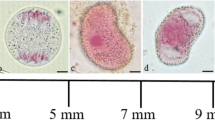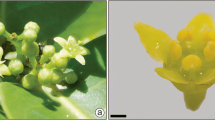Summary
In the present study, we studied changes in organellar DNA in the sperm cells of maturing pollen ofPelargonium zonale, a plant typical to exhibit biparental inheritance, by fluorescence microscopy after staining with 4′,6-diamidino-2-phenylindole (DAPI) and by immunogold electron microscopy using anti-DNA antibody. Fluorescence intensities of DAPI-stained plastid nuclei in generative and sperm cells at various developmental stages were quantified with a video-intensified microscope photon counting system (VIMPCS). Results indicated that the amount of DNA per plastid in generative cells increased gradually during pollen development and reached a maximum value (about 70 T per plastid; 1 T represents the amount of DNA in a particle of T4 phage) in young sperm cells at 5 days before flowering. However, the DNA content of plastids was subsequently reduced to about 20% of the maximum value on the day of flowering. Moreover, the DNA content of the plastid further decreased to 4% of the maximum value when pollen grains were cultured for 6 h in germination medium. In contrast, the amount of DNA per mitochondrion did not decrease significantly around the flowering day. Similar results were also obtained by immunogold electron microscopy using anti-DNA antibody. The density of gold particles on plastids decreased during pollen maturation whereas labelling density on mitochondria remained relatively constant. The number of plastids and mitochondria per generative cell or per pair of sperm cells did not change significantly, indicating that the segregation of DNA by plastid division was not responsible for the decrease in the amount of DNA per plastid. These results indicate that the plastid DNA is preferentially degraded, but the mitochondrial DNA is preserved, in the sperm cells ofP. zonale. While the plastid DNA of the sperm cells decreased before fertilization, it was also suggested that the low DNA contents that remain in the plastids of the sperm cells are enough to account for the biparental inheritance of plastids inP. zonale.
Similar content being viewed by others
Abbreviations
- DAPI:
-
4′,6-diamidino-2-phenylindole
- VIMPCS:
-
video-intensified microscope photon counting system
References
Baur E (1909) Das Wesen und die Erblichkeitsverhältnisse der “Varietates albo-marginate hort” vonPelargonium zonale. Z Vererbungsl 1: 330–351
Correns C (1909) Vererbungsversuche mit blass (gelb) grünen und buntblättrigen Sippen beiMirabilis jalapa, Urtica pilulifera undLunaria annua. Z Vererbungsl 1: 291–329
Corriveau JL, Coleman AW (1988) Rapid screening method to detect potential biparental inheritance of plastid DNA and results for over 200 angiosperm species. Am J Bot 75: 1443–1458
Heslop-Harrison J, Heslop-Harrison Y (1970) Evaluation of pollen viability by enzymatically induced fluorescence: intracellular hydrolysis of fluorescein diacetate. Stain Technol 45: 115–120
Hu S, Zhu C, Xu L, Shen J (1979) Ultrastructure of male gametophyte in wheat 1. The formation of generative and vegetative cells. Acta Bot Sinica 21: 208–214
Kuroiwa H, Ohta T, Kuroiwa T (1996) Studies on the development and three-dimensional reconstruction of giant mitochondria and their nuclei in egg cells ofPelargonium zonale Ait. Protoplasma 192: 235–244
Kuroiwa T (1991) The replication, differentiation, and inheritance of plastids with emphasis on the concept of organelle nuclei. Int Rev Cytol 128: 1–62
—, Kawazu T, Uchida H, Ohta T, Kuroiwa H (1993) Direct evidence of plastid DNA and mitochondrial DNA in sperm cells in relation to biparental inheritance of organelle DNA inPelargonium zonale by fluorescence/electron microscopy. Eur J Cell Biol 62: 307–313
—, Miyamura S, Kawano S, Hizume M, Tho-E A, Miyakawa I, Sando N (1986) Cytological characterization of NOR in the bivalent ofSaccharomyces cerevisiae. Exp Cell Res 165: 199–206
—, Kawano S, Nishibayashi S, Sato C (1982) Epifluorescent microscopic evidence for maternal inheritance of chloroplast DNA. Nature 298: 481–483
Li H, Sodmergen (1995) Maternal cytoplasmic inheritance and pollen nucleolytic activities in some Poaceae species. Japan Mendel Soc 60: 173–181
Metzlaff M, Borner T, Hagemann R (1981) Variations of chloroplast DNAs in the genusPelargonium and their biparental inheritance. Theor Appl Genet 60: 37–41
Miyamura S, Kuroiwa T, Nagata T (1987) Disappearance of plastid and mitochondrial nucleoids during the formation of generative cells of higher plants revealed by fluorescence microscopy. Protoplasma 141: 149–159
Mogensen HL (1988) Exclusion of male mitochondria and plastids during syngamy in barley as a basis for maternal inheritance. Proc Natl Acad Sci USA 85: 2594–2597
Nakamura S, Ogawa K, Kuroiwa T (1987) Survey of Ca2+-dependent nuclease in green plants. Plant Cell Physiol 28: 545–548
Ogawa K, Kuroiwa T (1985) Destruction of chloroplast nuclei of the male gamete by calcium and nuclease C in a cell model ofChlamydomonas reinhardtii. Plant Cell Physiol 26: 493–503
Palmer JD (1985) Comparative organization of chloroplast genomes. Annu Rev Genet 19: 325–354
Periasamy N, Armijo M, Verkman AS (1991) Picosecond rotation of small polar fluorophores in the cytosol of sea urchin eggs. Biochemistry 30: 11836–11841
Russel SD (1985) Preferential fertilization inPlumbago: ultrastructural evidence for gamete-level recognition in an angiosperm. Proc Natl Acad Sci USA 82: 6129–6132
— (1984) Ultrastructure of the sperm ofPlumbago zeylanica. II. Quantitative cytology and three-dimensional organization. Planta 162: 385–391
— (1980) Participation of male cytoplasm during gamete fusion in an angiosperm,Plumbago zeylanica. Science 210: 200–201
Schröder M-B (1985) Ultrastructural studies on plastids of generative and vegetative cells inLiliaceae. 3. Plastid distribution during the pollen development inGasteria verrucosa (Mill.) Duval. Protoplasma 124: 123–129
Sodmergen, Chen GH, Hu ZM, Guo FL, Guan XL (1995) Male gametophyte development inPlumbago zeylanica: cytoplasm localization and cell determination in the early generative cell. Protoplasma 186: 79–86
—, Luo YY, Kuroiwa T, Hu SY (1994) Cytoplasmic DNA apportionment and plastid differentiation during male gametophyte development inPelargonium zonale. Sex Plant Reprod 7: 51–56
—, Suzuki T, Kawano S, Nakamura S, Tano S, Kuroiwa T (1992) Behavior of organelle nuclei (nucleoids) in generative and vegetative cells during maturation of pollen inLilium longiflorum andPelargonium zonale. Protoplasma 168: 73–82
Author information
Authors and Affiliations
Rights and permissions
About this article
Cite this article
Nagata, N., Sodmergen, Saito, C. et al. Preferential degradation of plastid DNA with preservation of mitochondrial DNA in the sperm cells ofPelargonium zonale during pollen development. Protoplasma 197, 217–229 (1997). https://doi.org/10.1007/BF01288031
Received:
Accepted:
Issue Date:
DOI: https://doi.org/10.1007/BF01288031




